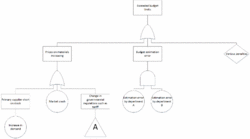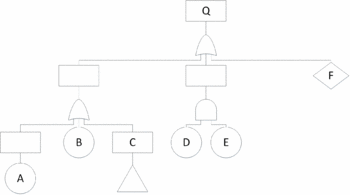Fault Tree Analysis in Projects
(→Application) |
|||
| Line 80: | Line 80: | ||
<br> | <br> | ||
For some projects it may not be necessary to execute step 3 if the focus is only to identify the risks and their dependencies with each other or if the team is unable to obtain the probabilities for the different base events. Calculating the probability for the top event to occur is however crucial in many projects and will indicate whether a project is not reliable and has a high likelihood of failing. In case the fault tree analysis indicates that there is a high probability of failure, the team may want to reorganize the project’s logic or structure in order to make it more reliable.<ref name="krysinski" /> | For some projects it may not be necessary to execute step 3 if the focus is only to identify the risks and their dependencies with each other or if the team is unable to obtain the probabilities for the different base events. Calculating the probability for the top event to occur is however crucial in many projects and will indicate whether a project is not reliable and has a high likelihood of failing. In case the fault tree analysis indicates that there is a high probability of failure, the team may want to reorganize the project’s logic or structure in order to make it more reliable.<ref name="krysinski" /> | ||
| + | |||
| + | ===Selecting top events=== | ||
In order to successfully apply FTA to a project, the project needs to be clearly defined in terms of the goals and success criteria. A project can be described by three variables that are to be measured: Budget/money spent, Timeframe/time used, or Quality which assesses the different goals in the project.<ref name="krysinski" /> Top events that are used in fault trees during project management will always relate to one of these three variables. While time and budget related top events are easy to measure, quality or performance related top events can be much more difficult. Performance related top events can be any type of event that doesn’t relate to time or budget, and is a way to measure the success or failure of the project based on bad performance or bad quality of deliverables.<ref name="krysinski" /> Since it is difficult to measure performance, it is very important that the success criteria have been defined from the beginning and there is a clear definition on what type of performance and/or quality that is deemed acceptable within the project.<ref name="krysinski" /> | In order to successfully apply FTA to a project, the project needs to be clearly defined in terms of the goals and success criteria. A project can be described by three variables that are to be measured: Budget/money spent, Timeframe/time used, or Quality which assesses the different goals in the project.<ref name="krysinski" /> Top events that are used in fault trees during project management will always relate to one of these three variables. While time and budget related top events are easy to measure, quality or performance related top events can be much more difficult. Performance related top events can be any type of event that doesn’t relate to time or budget, and is a way to measure the success or failure of the project based on bad performance or bad quality of deliverables.<ref name="krysinski" /> Since it is difficult to measure performance, it is very important that the success criteria have been defined from the beginning and there is a clear definition on what type of performance and/or quality that is deemed acceptable within the project.<ref name="krysinski" /> | ||
| + | |||
| + | ===Identifying risks=== | ||
Identifying the risks related to the project is of crucial importance, and the more thorough the risk identification is, the more detailed and insightful the fault tree becomes. Risk identification includes many different methods such as evidence based methods (i.e. historical data) or inductive reasoning techniques such as [[Hazard and operability study|Hazard and operability study (HAZOP)]].<ref name="ds" /> For the quantitative analysis, the probabilities of each of the identified risks need to be estimated in order to apply Boolean algebra and calculate the overall risk of the top event occurring. Some events can be based on evidence and other data such as market analyses that can estimate the probability of a shortage on a certain material. Other events are based on human activities such as budget estimation errors, which are much more difficult to estimate. Various methods exist that can be used to estimate human activity errors, such as [[Technique for human error rate prediction|Technique for human error rate prediction (THERP)]] or [[Performance shaping factors|Performance shaping factors (PSFs)]].<ref name="krysinski" /> | Identifying the risks related to the project is of crucial importance, and the more thorough the risk identification is, the more detailed and insightful the fault tree becomes. Risk identification includes many different methods such as evidence based methods (i.e. historical data) or inductive reasoning techniques such as [[Hazard and operability study|Hazard and operability study (HAZOP)]].<ref name="ds" /> For the quantitative analysis, the probabilities of each of the identified risks need to be estimated in order to apply Boolean algebra and calculate the overall risk of the top event occurring. Some events can be based on evidence and other data such as market analyses that can estimate the probability of a shortage on a certain material. Other events are based on human activities such as budget estimation errors, which are much more difficult to estimate. Various methods exist that can be used to estimate human activity errors, such as [[Technique for human error rate prediction|Technique for human error rate prediction (THERP)]] or [[Performance shaping factors|Performance shaping factors (PSFs)]].<ref name="krysinski" /> | ||
Revision as of 03:03, 17 September 2016
Fault tree analysis (FTA) is defined by the International Electrotechnical Commission (IEC) and the International Organization for Standardization (ISO) as a "technique for identifying and analysing factors that can contribute to a specified undesired event".[1]
FTA has its wide range of application in many fields of engineering such as systems engineering, reliability engineering, and safety engineering. It also serves as an applicable tool for identifying the causes of undesired events in projects. Undesired events in projects can for instance be exceeding the budget, time delays, lack of team synergy, or any other events that have a negative effect on the project. This is referred to as the top event.[2]
The purpose of FTA is to give both a qualitative and quantitative analysis of the factors that can trigger the undesired top event. A qualitative analysis shows via a graphical representation of a tree the top event that is to be analysed, along with the pathway of all the intermediate and base events that leads up to the top event. A quantitative analysis shows the probability of a top event being triggered by the input probabilities of the base events that leads up to the undesired event. The quantitative analysis is calculated through Boolean algebra.[3]
To do list:
- Write short history section.
- Write annotation for each bibliography source.
Contents |
History
Methodology
FTA is based on the analysis of a top event. This is an event that is believed to be of great importance to the project or an event which has not been given enough attention. A top event needs to be defined as a failure, as it is an undesired event that is to be avoided. Examples of such events can be the delay of the project if time is considered a constraint.[2][3] Other projects may be funded by a tight budget where it is crucial to stay within the budget's limits, therefore a top event could be failure to meet the expected budget.[2] Only one top event can be chosen for each fault tree, however it is often recommended to develop several fault trees[citation] each with their different top events if the project is of a large scale or if several top events are of great importance, such as the safety in a power plant.
Once a top event has been chosen, the causal factors for said event needs to be identified. Figure 1 is a representation of a basic fault tree with "Exceeded budget limits" as the top event. Beneath it all the causal factors located, that may trigger the top event. The graphical illustration of the fault tree consists of symbols with the intended purpose of clarifying the different relations between the different causal factors.
Symbols
| Symbol | Description |
|---|---|
| Event | An event is one of the causal factors that can occur during the progress of a project. This event will be responsible to fully or partially trigger the event located at an upper level. For the example in Figure 1 it can be seen on the far left that an increase in demand will result in the primary supplier being short on stock, which then results in prices on materials increasing. The increase in prices will then lead to the top event, which is a failure to complete the project within the budget. |

| |
| Base event | A base event is an event that is not analysed further because a further analysis on said event has been deemed not useful.[1] Whether to further investigate an event or not is up to the project members, however it is important to indicate all base events as they are later used in the quantitative analysis of the fault tree. For instance in Figure 1 it was deemed unnecessary to find further causal factors for a market crash, as the project members may have considered the causal factors to be outside the scope of the project or if they deemed it impossible to mitigate or treat the risks associated with any further causal factors. |

| |
| Unfinished event | Some events may not be of interest to the project at the current time, but may be of importance later in the project. These events are marked with this symbol so that the causal factors may be developed at a later stage in the project. An example is given in Figure 1 on the far right, where the project members were not currently interested in the causal factors for penalties but may develop these later in the project. |

| |
| Transfer | Many projects will have multiple fault trees developed with each of their own specific top event. Some of these fault trees may have many large portions identical with each other. In an effort to keep the many different fault trees as short and easily read as possible, transfer symbols may be used to indicate that the identical causal factors can be seen in another fault tree. Figure 1 shows a transfer symbol under the event for governmental regulations, to indicate that the causal factors for this event can be found in another fault tree, in order to not repeat the exact same causal factors. The transfer symbol in this example is marked with an "A" to differentiate between many other transfer symbols. |

| |
| OR gate | OR gates are used to describe the relations between the different causal factors in the same level. The OR gate indicates that any of the events beneath the gate can trigger the event above. As an example to this, Figure 1 indicates that there are 3 causal factors that can trigger the event where prices on materials increase. Either one of the 3 causal factors can trigger the upper event as they are not dependent on each other, therefore it is sufficient that just one of these events occur in order for the prices of material to increase. OR gates are indicated by a sum in the quantitative analysis using Boolean algebra. |

| |
| AND gate | AND gates are similar to OR gates, however now the causal factors depend on each other. An upper event will not occur until all of the causal factors under the AND gate occur. Figure 1 shows that in order for a budget estimation error to happen, not only must department A make the error but department B must also make the error for the estimation error to occur after the gate. If only one of the departments make the error but the other don't, then the upper event will not occur as the AND gate has not been satisfied. AND gates are indicated by a product in the quantitative analysis using Boolean algebra. |

|
Boolean algebra
Boolean algebra can be used for a quantitative analysis of a fault tree. By using Boolean algebra, it is possible to calculate the probability of different events, as well as the top event to occur. Figure 2 is the same fault tree as the previous fault tree in Figure 1, and all of the base events have been assigned a letter to identify them, with the assumption that the events governmental regulations and penalties are also base events. The top event is furthermore assigned the letter Q. For the quantitative analysis only the base events are of interest because they are the lowest causal factors, therefore the intermediate causal factors are of no importance to the analysis and are left blank.
OR gates denote a sum because the base events do not depend on each other while AND gates denote a product because the base events depend on each other. The algebraic representation of the fault tree thus becomes:
Which can be rewritten as:
If the probabilities of the base events are known, it is then possible to calculate the probability for the top event, Q, to occur. Based on the equation from Boolean algebra, it is possible to find the different paths that can occur in the fault tree for the top event to occur. These different paths are referred to as cut sets.[4] For instance if base event A occurs, then the top event will be triggered. The same goes for base events B, C, and F. However failure on base event D does not trigger the top event due to the AND gate, therefore a possible cut set with base event D would be DE as it requires base event E to occur as well. It is especially interesting in the case of a fault tree analysis to look at minimal cut sets, which are defined as the minimal amount of combinations of the base events that can cause the failure of the top event.[4]
Application
Risks will always be a part of projects, and the need to identify the risks and the impact they can have on projects can be crucial for the success of the project management. In general, FTA can be broken down into 3 steps when applying it to a project:[2]
- Defining the top event that is to be analysed.
- Constructing the fault tree with all the associated events that can lead up to the top event along with their appropriate gates to describe their relations. It is important that the lowest level of events (base events) have been identified as single tasks[2] where further analysis of said events would be deemed unnecessary for the overall analysis of the fault tree.
- Calculating the probability of the top event occurring by using Boolean algebra, in order to assess the reliability of the fault tree.
For some projects it may not be necessary to execute step 3 if the focus is only to identify the risks and their dependencies with each other or if the team is unable to obtain the probabilities for the different base events. Calculating the probability for the top event to occur is however crucial in many projects and will indicate whether a project is not reliable and has a high likelihood of failing. In case the fault tree analysis indicates that there is a high probability of failure, the team may want to reorganize the project’s logic or structure in order to make it more reliable.[2]
Selecting top events
In order to successfully apply FTA to a project, the project needs to be clearly defined in terms of the goals and success criteria. A project can be described by three variables that are to be measured: Budget/money spent, Timeframe/time used, or Quality which assesses the different goals in the project.[2] Top events that are used in fault trees during project management will always relate to one of these three variables. While time and budget related top events are easy to measure, quality or performance related top events can be much more difficult. Performance related top events can be any type of event that doesn’t relate to time or budget, and is a way to measure the success or failure of the project based on bad performance or bad quality of deliverables.[2] Since it is difficult to measure performance, it is very important that the success criteria have been defined from the beginning and there is a clear definition on what type of performance and/or quality that is deemed acceptable within the project.[2]
Identifying risks
Identifying the risks related to the project is of crucial importance, and the more thorough the risk identification is, the more detailed and insightful the fault tree becomes. Risk identification includes many different methods such as evidence based methods (i.e. historical data) or inductive reasoning techniques such as Hazard and operability study (HAZOP).[1] For the quantitative analysis, the probabilities of each of the identified risks need to be estimated in order to apply Boolean algebra and calculate the overall risk of the top event occurring. Some events can be based on evidence and other data such as market analyses that can estimate the probability of a shortage on a certain material. Other events are based on human activities such as budget estimation errors, which are much more difficult to estimate. Various methods exist that can be used to estimate human activity errors, such as Technique for human error rate prediction (THERP) or Performance shaping factors (PSFs).[2]
Minimal cut sets
Minimal cut sets are a part of the qualitative analysis of the fault tree, which seeks to find the smallest combination of the base events that will trigger the top event.[4][5] The minimal cut set is important to identify because it gives the idea of what events need to happen in order for the top event to occur, which helps the team determine which actions to take to improve the reliability of the fault tree.[5] By looking at the minimal cut sets of a fault tree, it can be seen which base events that are critical to the top event. Extra focus should be put on those events that can instantly trigger the top event. For instance base event A in Figure 2 is a minimal cut set because it is able to trigger the top event on its own, therefore additional risk treatment should be used on this base event in order to reduce the probability of this event occurring. However base events D and E depend on each other in order for the top event to occur, so less focus should be put on these. However it should also be noted that while minimal cut sets are of importance and show critical reliability problems in the fault tree, a subjective decision should also take place when treating the risks. For instance if base event A has a significant lower probability of occurring than the cut set DE then perhaps it is in the project team's best interest to focus on the latter as it has a higher probability.
Strengths and weaknesses
FTA offers many benefits for a project team to aid the overall successful completion of the project. The aim is to reduce the overall risk for a specific event within a project to occur and the method is able to cover many, if not all aspects of a project in terms of failure and success rate. By offering both a qualitative and quantitative analysis of the project risks, team members and project managers are able to create a visual representation of the project which results in in a quantitative analysis on the probabilities as a reference.
In particular, there are many strengths and benefits to be achieved from the FTA:
- A graphical overview of the risks involved that could contribute to the failure of the project.
- Additional fault trees can be created for the same project, taking several top events into consideration.
- The method offers a systematic approach that is still flexible enough to incorporate different types of causal factors such as human behavior and physical phenomena.[1]
- Logical analysis of events/risks and their interdependencies. By using logical gates it is possible to see the relations between the different events and get a better understanding of the project itself.[2]
- The possibility to reduce risks of certain events when studying the probabilities of said events. Furthermore the calculations of the probabilities for the top event to occur creates grounds for minimizing the risk for whether the project fails.
- Expanding the fault tree through the different AND/OR gates helps finding additional events that can cause the project to fail, which otherwise may not have been found due to uncertainty.[2]
- The choice of a top event allows for multiple different perspectives of a project to be analysed.[2] While time and budget events were the easiest to measure in terms of failure and success, it is still possible to analyse practically any other aspect of a project with adequately defined project goals or success criteria.
- Minimal cut sets help the project team prioritizing critical events that are more likely to trigger the top event to occur. This can also help the project manager save both time and money if they are able to correctly identify the risks that are most critical to the project and thus prioritizing accordingly.[1][5]
- FTA can be used with big and complex projects that can clarify the different interdependencies of the events, and can be easily analysed by using computer software.[1]
Limitations
As with many other tools, FTA has certain weaknesses and limitations that needs to be addressed as well:
- Probabilities for certain events are many times unknown due to uncertainty or lack of data. This can lead to inaccurate calculations of the probabilities of the top event which can have an adverse effect on the project.[1]
- It is not always possible to know whether all causal factors have been found for a particular top event or if more remain undiscovered.[1]
- As FTA is a static model, time-dimensions are not included which for many projects can be crucial.[1]
- As pointed out earlier, FTA is a systematic approach that allows flexible causal factors, however due to FTA only dealing with binary states (fail/success), it may not be flexible enough for certain projects.[1]
- It is rather difficult to include conditional factors into the fault tree.[1]
- Failures of degree are often difficult to implement into FTA. For instance, when dealing with top events that are either time delay or budget spendings, an increase in time may not result in the project being delayed, and similarly an increase in project spendings may not result in the budget being exceeded.[1]
See also
References
- ↑ 1.00 1.01 1.02 1.03 1.04 1.05 1.06 1.07 1.08 1.09 1.10 1.11 IEC/ISO 31010, "Risk management - Risk assessment techniques", 2009
- ↑ 2.00 2.01 2.02 2.03 2.04 2.05 2.06 2.07 2.08 2.09 2.10 2.11 2.12 Marcin Krysinski, and George Anders, "Fault Tree Analysis in a Project Context", 2005
- ↑ 3.0 3.1 Silvianita, Dirgha S Mahandeka, and Daniel M Rosyid, "Fault Tree Analysis for Investigation on the Causes of Project Problems", 2015
- ↑ 4.0 4.1 4.2 weibull.com - Reliability Engineering Resource Website Retrieved: September 16, 2016
- ↑ 5.0 5.1 5.2 Robert Beresh, John Ciufo, and George Anders, "Basic Fault Tree Analysis for use in Protection Reliability", 2009



